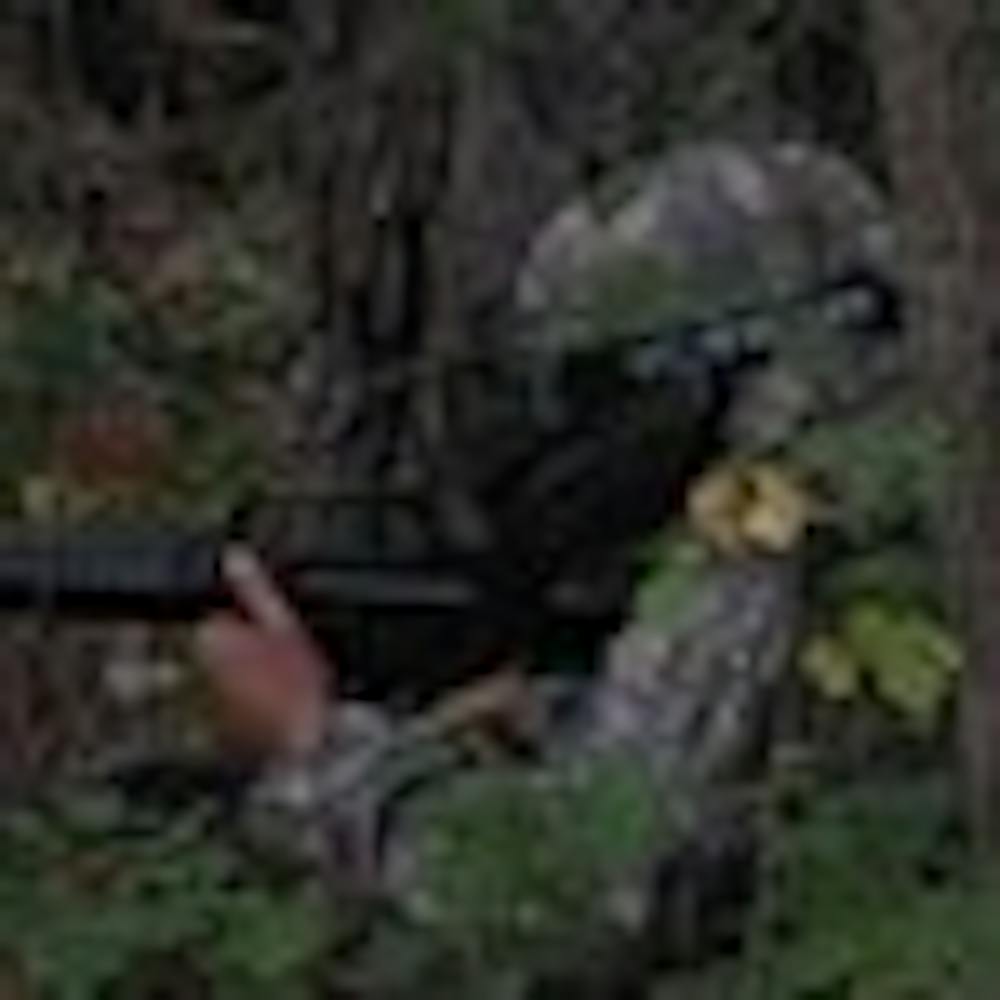The cadets of the Reserve Officers' Training Corps stood in the parking lot outside of Atlantic House at 6:50 a.m. last Saturday checking and rechecking to make sure their 35-pound rucksacks were fully packed.
One cadet gulped down a large cup of McDonald's coffee. Another munched on a breakfast bar. By roughly 7:30 a.m. the cadets had piled into two stark white buses and embarked for Fort Lee, Va., for the first overnight field training exercise of the year.
After a 45-minute bus ride, the cadets unloaded into a clearing equipped with bleachers, a gazebo and a brown, looming, 50-foot-tall rappel wall. The cadets arranged their gear in straight lines and then lined up in a similar fashion as their leader addressed them.
"This is about as good as it gets for ROTC," said Maj. Jason Garkey, the University of Richmond's new professor of military science. "The only thing I ask for is 48 hours of motivation and dedication."
First on the agenda: how to move on a battlefield without getting killed. Half of the cadets donned their rucksacks and walked past signs posted on barbed-wire fences reading, "DANGER: EXPLOSIVES KEEP OUT," to a field where they learned how to properly crawl in combat. After practicing the crawls individually, the cadets learned how to move with, and cover, a fellow soldier on the battlefield.
Virginia Commonwealth University senior Marie Elliott watched a cadet whose feet were sticking up when she crawled.
"Keep 'em down!" Elliott said. "You'll get your feet shot off."
VCU alumnus Daniel Fornicola helped oversee the individual movement training. Fornicola will begin his Army training at Fort Bragg in North Carolina in February, he said. For now, he is acting as a Gold Bar Recruiter for the Spider Battalion and doing administrative work.
"It's a way to give back to the battalion," he said. "We love this stuff."
Once the cadets had practiced moving with a buddy, it was time to put the training to some practical use. Outfitted with flak jackets and facemasks, they trudged into the woods and practiced moving to cover with a buddy while Fornicola and another officer fired paintballs at them.
"Buddy, cover me while I move!" the cadets shouted.
"Gotcha covered!" their buddies shouted back.
Enjoy what you're reading?
Signup for our newsletter
Capt. Nathaniel Merrigan, assistant professor of military science at Longwood University and Hampden-Sydney College, offered the cadets some advice as they dashed to cover behind trees and stumps: "Don't get shot!"
Some cadets weren't loud enough while letting their buddies know they were moving.
"You've got to scream and yell," Merrigan told them. "The battlefield is a very loud place."
Capt. Adriana Ramirez was also making sure everything ran smoothly while the cadets trained under some real fire.
"They did the crawl," she said. "This is supposed to be like the walk ... and the paintballs are always fun."
Back in the clearing with the rappel tower, cadets learned how to properly evaluate casualties on the battlefield. After that, it was time to rappel.
The cadets formed a circle around a senior officer. He took a piece of thick, green rope, and after tying a series of knots around his waist and groin, formed a makeshift harness. This harness - better known as a Swiss Seat - is as sturdy as a harness but a lot more uncomfortable.
Maj. Mark Baush, training officer for the Spider Battalion, demonstrated to the cadets how to properly rappel. He said he wanted his demonstration to build the cadets' confidence, as well as test the ropes.
Standing backwards atop the 50-foot tower with his feet halfway over the edge, Baush locked his knees and leaned back until his body was in a perfect "L" shape.
An officer at the bottom of the wall, known as the "belay man," gripped the rope to which Baush was attached in case he lost his grip. With a push of his legs, Baush zipped down the 50-foot wooden structure in a matter of seconds.
"If I just let go of everything, the belay man is going to save [me]," he said.
One by one, the cadets climbed the tower, making sure to have all of the necessary equipment. Should cadets forget to wear their heavy leather gloves, they would end up with some nasty rope-burn.
One by one the cadets zipped down the tower just as Baush had a few moments earlier. After each cadet rappelled, he or she took over belay duties while the next person went down the tower.
Once all of the cadets had finished rappelling, they settled down to eat Meals-Ready-to-Eat, known as MREs - individual high-calorie meals meant to keep soldiers energized. There are a variety of MRE choices, ranging from pasta with chicken and pesto to an omelet.
"They're not as bad as you'd think but they aren't as good as you'd want," said Richmond senior Robi DeBell, the battalion's public affairs officer.
Land navigation was the final activity of the day. Beginning at 2 p.m., groups of cadets moved into the woods and were given eight locations, five of which had to be found in five hours. After passing land navigation in daylight, cadets must train at night, having to find three of five locations in three hours.
And after that, the cadets slept outside, taking shifts in setting up a 360-degree perimeter around the site.
"We sleep in sleeping bags outside," Fornicola said. "Even if it rains."
The cadets had come prepared to sleep under the stars.
"The mosquitoes were really bad last year," said Richmond sophomore Pat Coughlin, who split a $10 mosquito net with another cadet for this time around.
Garkey, who became Richmond's professor of military science in June 2009, was pleased with the performance of the senior cadets, who were responsible for coordinating and running the training exercise. Before taking his position, Garkey served as an officer assigned to the U.S. Northern Command's Chemical, Biological, Radiological, Nuclear and High-Yield Explosive Consequence Management Response Force, which provides responses to nuclear or chemical events in the United States.
Garkey stressed that he wanted to get the program more involved on campus. "We do more than just go to class and go into the woods," he said. "We owe back to the campuses that we're on.
"Units embed with the communities they're working in ... and they make it a better place. You don't have to be in Iraq or Afghanistan."
Contact staff writer Guv Callahan at guv.callahan@richmond.edu
Support independent student media
You can make a tax-deductible donation by clicking the button below, which takes you to our secure PayPal account. The page is set up to receive contributions in whatever amount you designate. We look forward to using the money we raise to further our mission of providing honest and accurate information to students, faculty, staff, alumni and others in the general public.
Donate Now



